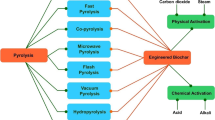Abstract
Exopolymers produced by bacteria cells during copper bioleaching from copper sulphides could modify the relative cell surface charge and thus change the relation between cell and substratum surfaces. All examined bacterial strains showed a hydrophilic cell surface independent of relative surface charge and adhesion depended on presence or absence of exopolymer. The effect of exopolymers on adhesion processes differed according to the strain and was clearer in the case of pure culture. © Rapid Science Ltd. 1998
Similar content being viewed by others
References
Bennet, JC and Tributsch, H (1978). J Bacteriol 134: 310–317
Ehrlich, HL (1992).Ore leaching by microbes. In Encyclopedia of Microbiology, J Lederberg, ed vol 3 pp 283–288, Academic Press Inc
Gerson, DF and Scheer, D (1980). Biochim Biophys Acta 602: 506–510
Hermansson, M, Kjelleberg, S, Korhonen, TK and Stenström, T (1982). Arch Microbiol 131: 308–312
Huysman, F and Verstraete, W (1992). Biol Fertil Soils 16: 21–26
Kelly, DP and Harrison, AP (1986). Genus Thiobacillus. In Bergey's Manual of Systematic Bacteriology PHA Sneeath, NS Mair, ME Sharpe. and D White eds. Vol 3 pp 1842–1858, Wiliams and Wilkins, Baltimore
Laskowski, J (1969). Physical Chemistry in Mechanical Mineral Processing. “Ślaçsk” Publishers, Katowice.
Miller, JC (1972). Experiments in molecular genetics. Cold Spring Harbor Laboratory, Cold Spring Harbor, New York
Marshall, KC (1985). Mechanism of bacterial adhesion at solid-water interfaces. In: Bacterial Adhesion, DC Savage. and M. Fletcher, eds pp 133–161, Plenum Press, New York
Ostrowski, M, Skłodowska, A and Kunicki-Goldfinger, W (1990). Acta Microbiol Polon 39: 71–78
Ostrowski, M and Skłodowska, A (1993). World J Microbiol Biotechnol 9: 238–331
Pedersen, K (1981). FEMS Microbiol Lett 12: 365–357
Rodriquez-Leiva, M and Tributsch, H (1988). Arch Microbiol 94: 401–405
Rosenberg, M (1984). FEMS Microbiol Lett 22: 289–295
Rutter, RR and Vincent, B (1980). The adhesion of microorganisms to surfaces: physico-chemical aspects. In: Microbial adhesion to surfaces RC Berkeley, JM Lynch, J Melling, PR Rutter, and B Vincent, eds pp 79–92, Society of Chemical Industry, London
Silverman, MP (1967). Mechanism of bacterial pyrite oxidation. J Bacteriol 94: 1046–1051
Silverman, M, Belas, R and Simon, M (1984). Genetic control of bacterial adhesion. In: Microbial adhesion and aggregation KC Marshall ed pp 95–109, Springer-Verlag
Skłodowska, A, Matlakowska, R and Ludwig, W (1996). Acta Microbiol Polon 45:131–141
Skłodowska, A and Matlakowska, R (1997). Biotechnology Techniques 11: 837–841
Sorongon, ML, Bloodgood, RA and Burchard, RP (1991). Appl Environ Microbiol 57: 3193–3199
Wrangstadh, M, Conway, PL and Kjelleberg, S (1986). Arch Microbiol 59:3280–3286
Author information
Authors and Affiliations
Rights and permissions
About this article
Cite this article
Sklodowska, A., Matlakowska, R. Relative surface charge, hydrohobicity of bacterial cells and their affinity to substrate during copper bioleaching from post-flotation wastes. Biotechnology Letters 20, 229–233 (1998). https://doi.org/10.1023/A:1005365516405
Issue Date:
DOI: https://doi.org/10.1023/A:1005365516405




